
Conversation

How to Actually Do Competitor Research
Let’s revisit the Five Fits Framework from our Growth Fundamentals unit:

To guide your research, we’ll be applying the same framework to the competitors you’ve identified to find out more about their growth strategies. Use our competitor research template to record your findings.
The first step is getting a high-level overview of who exactly these competitors are. This basic info gives background and context about the amount of time and resources it took for your competitors to reach their current stage.
Use Crunchbase, LinkedIn, or Owler to find this info, including:
- Founding year
- Founder
- CEO
- Location(s)
- Number of employees
- Investors/funding
- Revenue
- Number of customers
Also try Googling press releases and interviews with your competitors’ execs—you can often find revenue data this way.
Then move on to finding out your competitors’ growth tactics, specifically by studying their landing pages, ads, and content marketing. We’ll walk you through this—but remember that your research here shouldn’t be overly concerned with uncovering finer details like your competitors’ monthly ads budget. It’s more about finding what messaging and channels successful companies similar to yours are using, so you can better plan out your own growth strategy.
Landing pages
The easiest place to start with researching any competitor is their website. Pay attention to how they describe their brand and products, specifically their:
- Problem: The pain point your competitors focus on solving. How do they relate this to the user?
- Features: The design and tech behind their product. What features do they emphasize the most?
- Pricing: How much they charge. Are any segments of your audience priced out? Do they offer different pricing plans?
- Perks: The bonuses that come with the product, like early access to new features, an exclusive Slack community, etc. What makes these perks appealing?
The point of studying your competitors’ websites isn’t to do a feature-by-feature product comparison with your own. Instead, consider how they’re communicating their product’s value. What story does your competitor tell? How do they describe the benefits of using their product? And how do they position their product relative to others?
For example, here are some notes about Otter.ai based on its website.
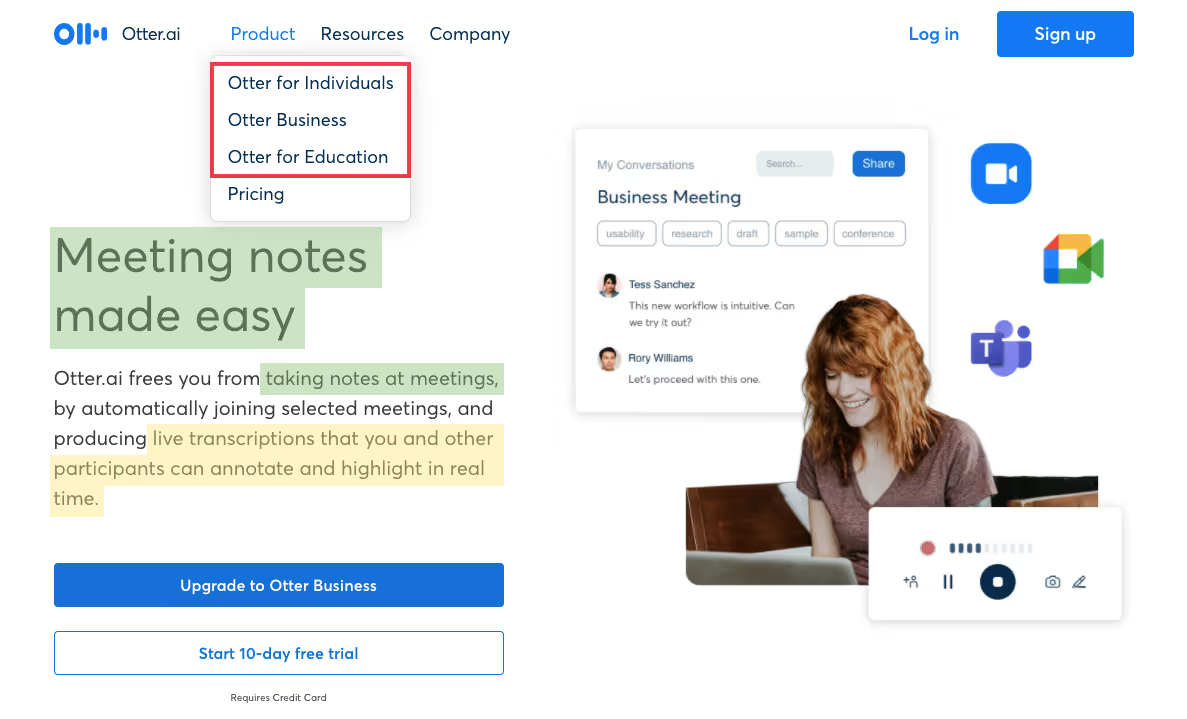
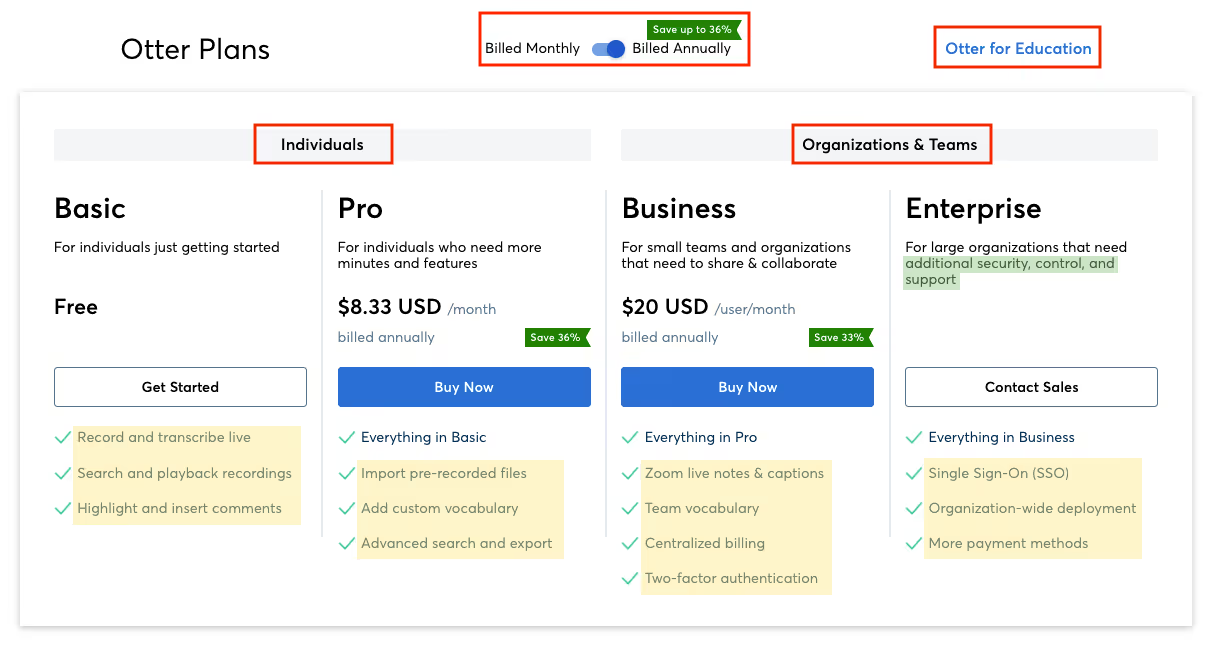
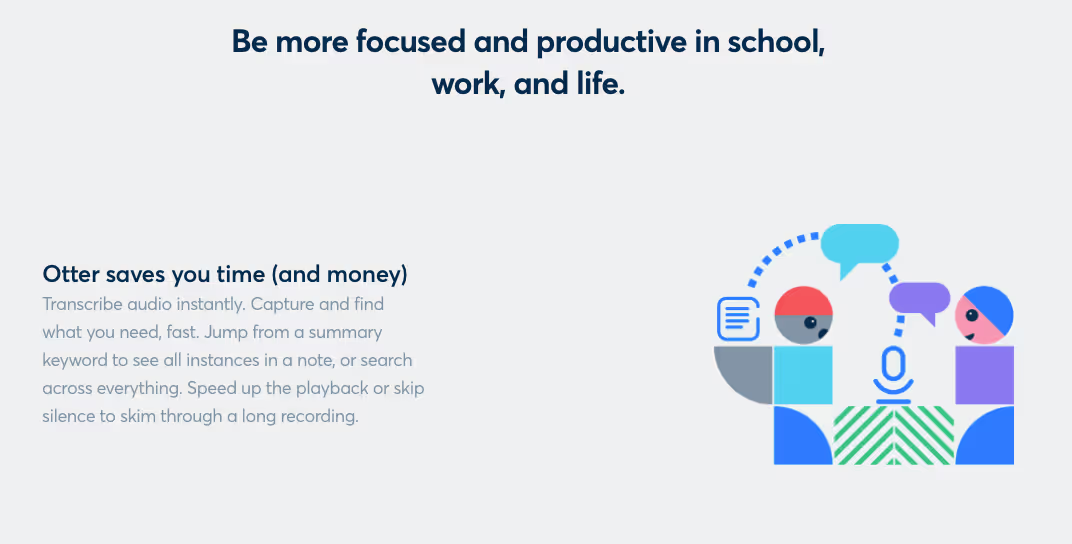
- Problem: The main pain point Otter.ai addresses is note-taking at meetings.
- Features: Otter.ai emphasizes its live and automatic transcriptions, note-taking, and meeting analytics.
- Pricing: There are two broad pricing categories for individuals and businesses, plus a specialized plan for those in education.
Otter.ai sells a voice transcription software, but its brand messaging focuses on how the company improves productivity by making information more accessible—and doing so cost-effectively. Its biggest benefits: efficiency and convenience. Interestingly, it doesn’t refer to competitors or claim to be the best transcription service out there. Instead, it positions itself as a necessity alongside other remote communication tools like Zoom and Google Meet.
A/B tests
While browsing your competitors’ pages, you might notice URL parameters, like:
http://www.example.com/?optimizely_opt_out=true
This may be a sign of an ongoing A/B test—something worth noting because it means your competitor is trying to optimize some aspect of their site.
If you notice this, open the same URL in your browser’s incognito mode. Refresh until you see the page visually change. Then take screenshots to compare the variants. Use them to find and reverse engineer whatever hypothesis they’re testing. That might be:
- New value propositions
- Different product imagery
- Social proof, e.g. testimonial videos instead of written quotes
Even though you can’t see the results of their A/B test, you can consider whether the same variables are also worth testing on your site.
Ad channels
Another benefit of visiting your competitors’ sites: getting retargeted. Browse social media and elsewhere without an ad blocker to see what retargeting ads appear for your competitors.
Pay attention to the ads with the most comments and reactions. This might reveal which ads are shown most often—potentially the most successful ones.
Besides retargeting ads, also dig into Google, Facebook/Instagram, and LinkedIn to find out what other campaigns your competitors are running. Consider:
- Which platforms are they advertising on?
- What users do they target?
- Where do their ads send users? Sales pages, blog posts, etc.
If your competitors have focused on a specific platform, it’s worth checking out that platform’s upcoming competitors—you might find lower CACs with these new channels. For example, many consumer brands are focused on TikTok rather than Facebook because it’s cheaper and less saturated.
Google search ads
To find out what keywords competitors target in their search ads, use Ahrefs.
- Enter your competitor’s URL.
- Scroll down to find Paid Search in the sidebar. Click to expand the menu.
- Click PPC keywords.
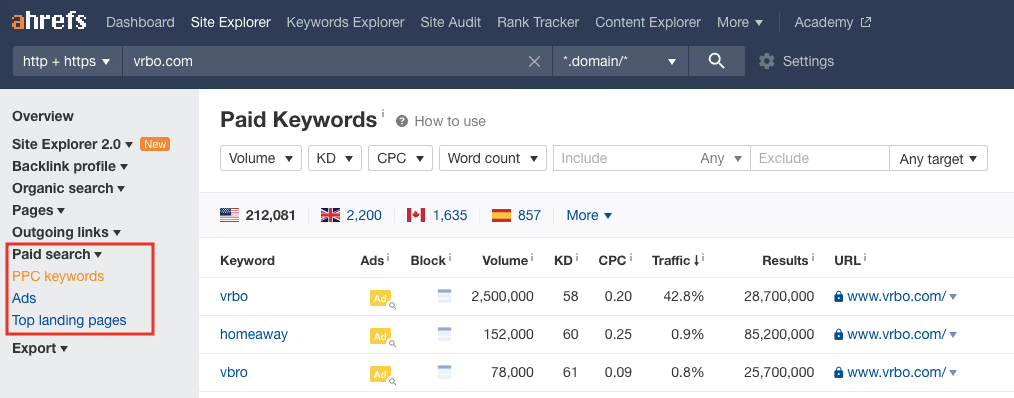
Ahrefs also shows the top landing pages competitors’ search ads lead to if you click Top landing pages. This is helpful for understanding how companies are segmenting users based on value props and audience type.
For example, Ahrefs’ data shows that Vrbo targets travelers interested in vacationing in the South, especially Florida. It targets several location-specific keywords and directs users to a corresponding targeted search page, like one specifically for Gatlinburg cabin rentals.
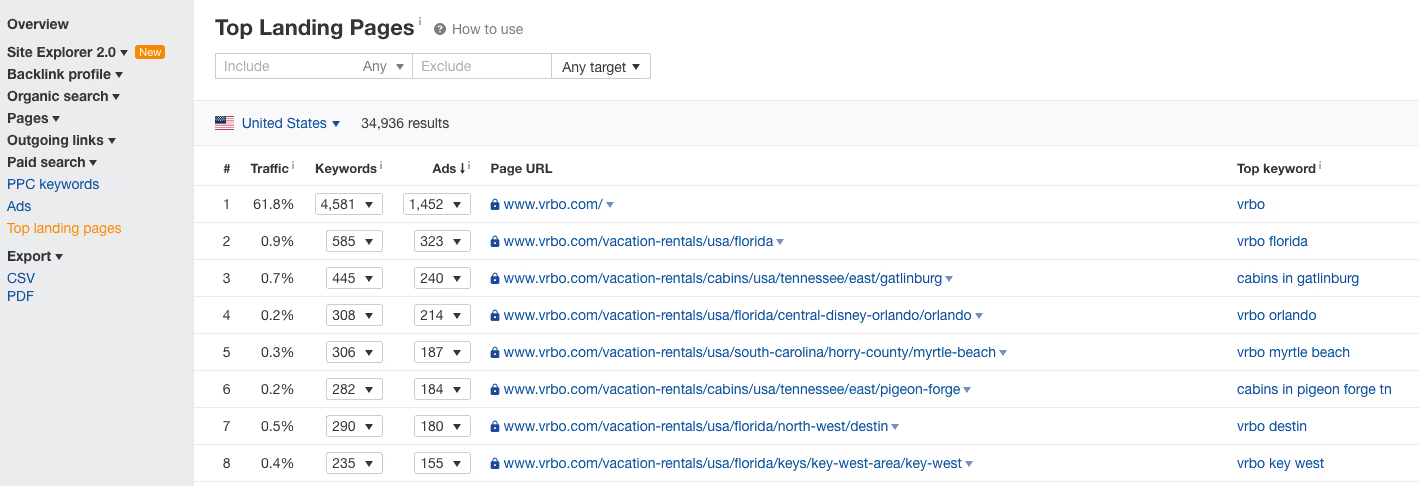
Creative inspiration tools
There are some great tools out there for finding, saving, and analyzing curated ad creatives from all kinds of companies.
Not only can you use them to search for terms related to your industry, you can also look up specific competitors.
You can then use those as inspiration boards for yourself, for your team, or for your clients.
Here are the two tools we recommend:
- Foreplay: The tool we use internally with our agency to gather inspiration to use internally and to share with clients.
- Atria: A competitor to Foreplay that also has some analytics tooling (at additional cost).
Here's a walkthrough of how to use Foreplay:
Meta and LinkedIn Ad Libraries
Here are the links to the ad libraries:
These tools let you search for the ads being run by specific companies.
Here's a walkthrough of how to do just that:
If you decided to use Foreplay or Atria, then save any great ads you find to your boards.
Content marketing
SEO
Use Ahrefs or Semrush to find out the top keywords your competitors rank for, plus estimates for how much traffic each of their pages get. Although they’re not always accurate, these estimates give clues on what landing pages and blog posts drive the most visitors to your competitors.
Take a look at the top-performing pages and how they’re structured.
- What types of keywords do they rank highly for?
- What is the goal of the content—to educate, entertain, sell, or something else?
- Who is the content written for?
Ahrefs’ Top Content option also shows which pages have received the most backlinks. Don’t fixate on the specific number of backlinks; instead, consider what themes are common across your competitors’ most popular pages.
For example, several of Zapier’s top blog posts are listicles about productivity apps.
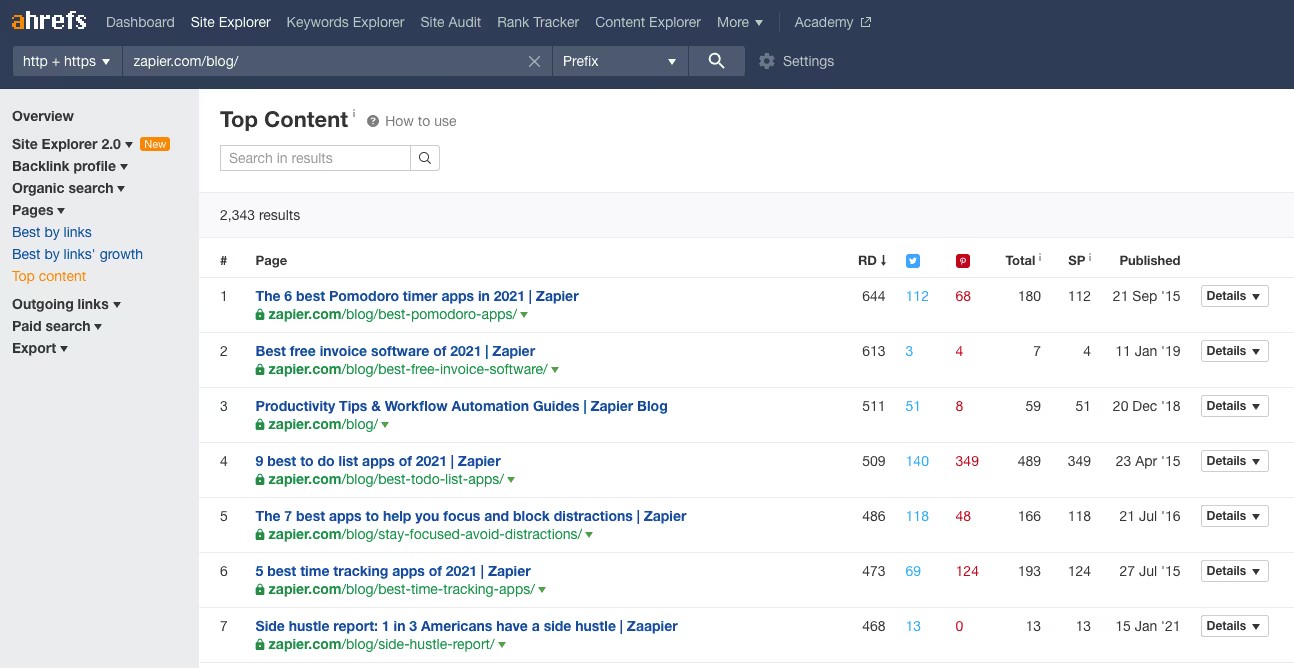
Ahrefs’ data on social performance isn’t as strong, so use BuzzSumo to find out which pages have gotten the most shares. Here’s Zapier again, with different blog posts getting lots of traction on social media.
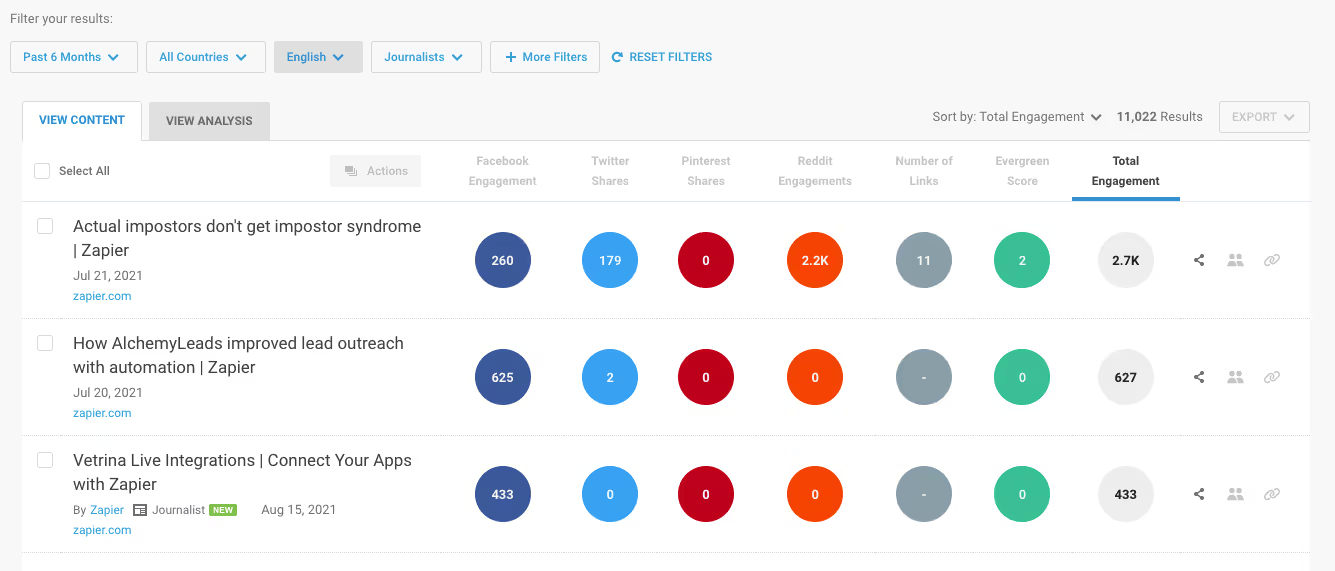
You can then cross-check these pages in Ahrefs to find out their organic keywords—a great way to find the sweet spot of content topics that have high search volume and reader interest.
Brand awareness
Use Google Trends to find out how branded searches for your competitors have changed over time. These charts act as rough proxies for how well a company is doing. If searches for a company’s name are going down, their awareness may be declining, which could mean their growth efforts are failing.
On the other hand, more recent branded searches might mean their growth tactics are working—but you should always take this with a grain of salt. There could be other reasons outside of a company’s control for why branded searches have spiked.
For example, you can see that happen for WeWork in fall 2019, when its IPO failed.

Still, Google Trends’ data can be a helpful barometer for understanding how a company’s brand awareness has grown over time. A steady decline is also worth studying as a cautionary tale for what might have gone wrong.
Social media
When studying competitors’ social media, it can feel overwhelming to look through so many channels. It’s also tempting to fixate on vanity metrics like likes and followers—but these numbers are often misleading because companies can pay to inflate them.
We don’t recommend an intensive audit here—the goal is to find out if organic social media is worth pursuing as a growth strategy. Focus on answering these three questions:
- Are competitors using social media? This isn’t just about whether they have an Instagram page. Do they actively post new content? If companies last posted more than six months ago or do so very sporadically, it’s a good sign that they’re not really investing in social media. Or, if they used to create a lot of YouTube videos but no longer, then it may mean that the ROI wasn’t there.
- If competitors are active on social media, how are they using it? Which platforms do they use? Do they partner with influencers? Skim through your competitors’ active channels to get an idea of their messaging and the nature of their content. For example, some companies focus on creating educational content like HubSpot’s YouTube channel. Others provide entertainment, like BarkBox’s Instagram.
- How do users respond to their content? Avoid putting a lot of weight on followers and likes. Instead, look at comments on your competitors’ active channels. Companies can buy comments, too, but it’s easier to identify fake ones (usually a single word or only emojis). See if users are leaving meaningful comments. If so, what is the consumer sentiment? A few quick ways to identify the most popular content on some channels:http://instagram.com/bark/
- Twitter/X: The Twemex Chrome Extension allows you to search through the top tweets/posts from a creator/company. Simply navigate to their profile and the sidebar will show their top posts. You can thens search them to drill down further.
- Instagram: Study competitor accounts on desktop. You can’t easily sort posts but you can hover your cursor over them to see how many likes and comments they’ve received. Study posts with the most comments.
- YouTube: Go to a channel’s videos, and click the Sort by dropdown menu. Sort by “Most popular” to see which videos got the most views; then click to see their comments.
- TikTok: You can’t sort a TikTok account’s videos by likes, but the view count is shown on each video thumbnail in their feed. This number is insightful in itself because it tells you which videos grabbed users’ attention. Look for those with the most views; then click to see its likes and comments.
Remember: The point here isn’t to dissect your competitors’ social media performance, but rather, see whether users actually care about it. Authentic user comments are a good barometer for this because only the most engaged people will respond.
For example, let’s look at the ecommerce company Beardbrand. Its website shows it uses Facebook, Instagram, Twitter, and YouTube, so we’ll quickly scan through each.
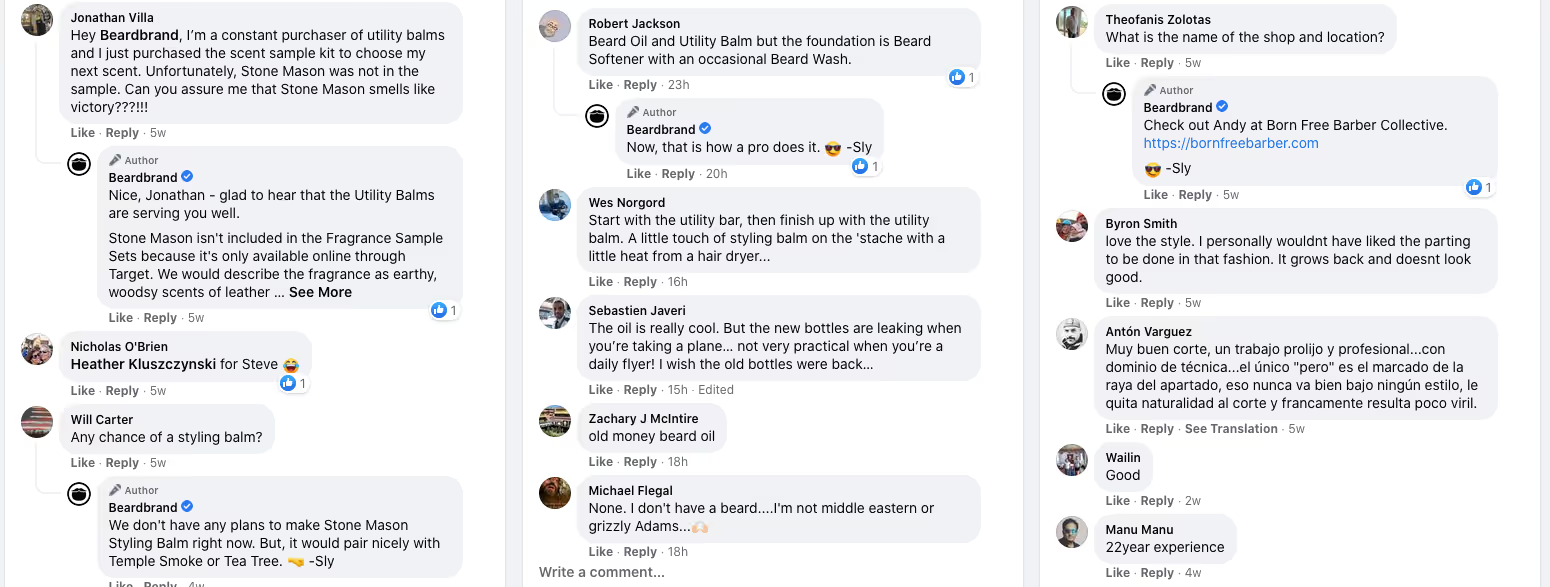
- Facebook/Instagram: BeardBrand regularly posts the same content on these two connected channels. Only a few posts get reshared by Facebook users. Some comments are specific to BeardBrand’s products; many others are enthusiastic reactions to BeardBrand’s videos. Instagram Reels get a lot more thoughtful comments than static image posts.
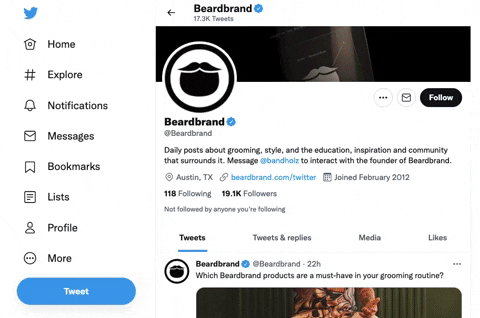
- Twitter: Also an active channel, but a quick scroll through the feed shows a pretty low level of user engagement (very few replies or retweets) on the majority of tweets. This tells us that Twitter probably isn’t a great platform for reaching customers.

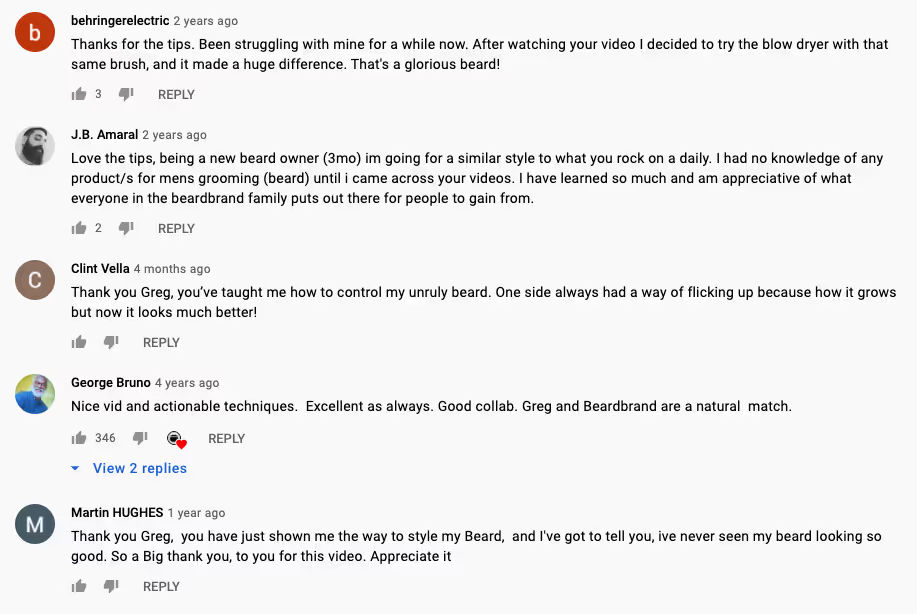
- YouTube: Sorting BeardBrand’s videos by newest shows that it releases new videos every day, with a lot of recent content in portrait orientation (probably repurposed from Facebook/Instagram). When you sort the videos by popularity, you can see that the most viewed are landscape videos—and receive way more views than on any of their other channels. BeardBrand’s top videos also receive thousands of comments, with many users showing appreciation, even gratitude.
Overall, BeardBrand’s organic social content is casual, friendly, and encouraging. Looking at all of its active channels, YouTube clearly generates the most genuine user engagement. The top videos are mostly barber transformation videos and tutorials—not very promotional compared to the other channels, which announce giveaways or new products.
While we can’t see BeardBrand’s conversions from organic social, this quick audit tells us video content in this niche may be most effective, especially on YouTube. It also looks like users respond most to inspiring or educational content.


